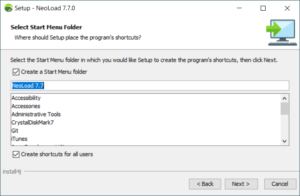

Lastly, a rehearsal quiz has been provided for you to familiarize yourself with the format and style of the certification exam. We also have documentation on NeoLoad which include quick start guides, install, and more! We recommend taking a thorough look through our library of Neoload content available on the Tricentis Academy YouTube channel at. Make sure to review our Neoload content to ensure that you are sufficiently prepared to take this exam.
#NEOLOAD ICON PROFESSIONAL#
However, it doesn't currently have significant browser support to be used in real projects.The NeoLoad Professional Certification program is an exam which consists of multiple choice questions.īefore taking the exam, note the following information:
#NEOLOAD ICON DOWNLOAD#
The last technique involves using the File System Access API and gives us better control over different aspects of the process like changing the default download location with the user's permission. The first two techniques require us to create anchor tags and assign values to their href and download attributes. In this tutorial, we learned three different techniques of creating and saving files in JavaScript. The demo will not work in Firefox, so you should try using Chrome or Edge. Try writing something in the textarea of the following CodePen, and then click on the Save File button. At this point, the content from the stream is saved to the file. The createWritable() method creates a writable stream, and we write the blob we created earlier to this stream. This method returns a FileSystemFileHandle on which we can call the createWritable() method. We can suggest a name to save the file here and also pass an array of allowed file types to save. We create an object that contains different options for our file picker that shows up when we call the showFilePicker() method. tAttribute('download', `$.txt`,Ĭonst fileHandle = await window.showSaveFilePicker(pickerOptions) Ĭonst writableFileStream = await fileHandle.createWritable() Īs usual, we begin by creating a blob of the text inside the textarea element. tAttribute('href', 'data:text/plain charset=utf-8,' + encodeURIComponent(text)) Here is an example: const link = document.querySelector('a.dynamic') JavaScript can be very handy when you want to make the whole thing dynamic. Here is an example of using all these attributes together: Download Text File with Name We can use the download attribute to specify the name of the file where we want to put all our content after download.

We specify our actual data after all these tokens. The base64 token is optional and is needed only when you want to store binary data textually. Its default value is text/plain charset=US-ASCII. The mediatype token is actually a MIME type that specifies the nature and format of a document or file. These URLs follow the following syntax: data:, They are ideal for embedding small files in your HTML documents.

These data URLs are special URLs that are prefixed with the data: scheme. The easiest way to save a file is to use Data URLs that include all the relevant information. We will discuss three different techniques that you can use to do so.
#NEOLOAD ICON HOW TO#
In this tutorial, you will learn how to create and save files with JavaScript. With the advancements in web standards, we have been using it to accomplish more and more tasks that were earlier either very difficult or impossible to do with just JavaScript. JavaScript is one of the most popular programming languages around, primarily because it handles the front-end of websites while running inside a browser.


 0 kommentar(er)
0 kommentar(er)
